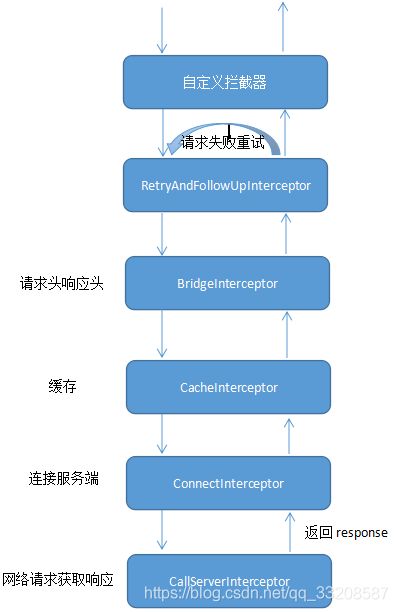Okhttp3 源码分析
最近详细的看了一下okhttp的源码,okhttp是一个开源的网络请求框架,本文导入的okhttp版本为
implementation 'com.squareup.okhttp3:okhttp:3.12.1'okhttp请求可以分为同步以及异步,本文分为三部分:同步、异步、拦截器链,进行简单分析。
1.同步
同步的使用如下:
OkHttpClient client = new OkHttpClient();
Request request = new Request.Builder().url(urlString).build();
Call call = client.newCall(request);
Response response = call.execute();同步使用call.execute()开始网络请求。execute实现在RealCall.java中
//RealCall.java
@Override public Response execute() throws IOException {
...
try {
client.dispatcher().executed(this);
Response result = getResponseWithInterceptorChain();
if (result == null) throw new IOException("Canceled");
return result;
} catch (IOException e) {
...
} finally {
client.dispatcher().finished(this);
}
}先来看try中第一句,其实就是调用Dispatcher.java的executed方法
//Dispatcher.java
synchronized void executed(RealCall call) {
runningSyncCalls.add(call);
}executed方法就只有一句话,往runningSyncCalls中添加RealCall实例,那么这个runningSyncCalls是什么呢?找到Dispatcher文件的开头,会看见定义了三个队列
/** Ready async calls in the order they'll be run. */
private final Deque readyAsyncCalls = new ArrayDeque<>();//异步的等待队列
/** Running asynchronous calls. Includes canceled calls that haven't finished yet. */
private final Deque runningAsyncCalls = new ArrayDeque<>();//异步的运行队列
/** Running synchronous calls. Includes canceled calls that haven't finished yet. */
private final Deque runningSyncCalls = new ArrayDeque<>();//同步的运行队列 executed方法就是往同步的运行队列里添加了RealCall实例。
再回到RealCall.java中execute方法try中的第二句,可以直接看到Response通过getResponseWithInterceptorChain方法获取到了,那么网络请求肯定是这个方法里面执行的。getResponseWithInterceptorChain这个方法通过英文可以大概知道是通过拦截链来获取结果的。okhttp的拦截策略后面再讲,因为异步也是通过这个方法获取结果。
那么来到execute方法的最后finally中,其实就是调用Dispatcher.java的finished方法
void finished(RealCall call) {
finished(runningSyncCalls, call);
}
private void finished(Deque calls, T call) {
Runnable idleCallback;
synchronized (this) {
if (!calls.remove(call)) throw new AssertionError("Call wasn't in-flight!");
idleCallback = this.idleCallback;
}
boolean isRunning = promoteAndExecute();
if (!isRunning && idleCallback != null) {
idleCallback.run();
}
} 可以从代码中看到calls.remove(call),将这个请求从同步的运行队列中移除,idleCallback可以忽略,并没有对this.idleCallback赋值,下面来到promoteAndExecute这个方法,进入这个方法可以看见全部是与异步有关,相当于同步只是走一遍判断,这个方法就结束了(promoteAndExecute具体分析放在异步中)。
到这里同步就结束了。
2.异步
异步的使用如下:
OkHttpClient client = new OkHttpClient();
Request request = new Request.Builder().url(urlString).method("GET", null).build();
Call call = client.newCall(request);
call.enqueue(new Callback() {
@Override
public void onFailure(Call call, IOException e) {
}
@Override
public void onResponse(Call call, Response response) throws IOException {
}
});异步使用call.enqueue()开始网络请求。enqueue也是实现在RealCall.java中
//RealCall.java
@Override public void enqueue(Callback responseCallback) {
synchronized (this) {
if (executed) throw new IllegalStateException("Already Executed");
executed = true;
}
captureCallStackTrace();
eventListener.callStart(this);
client.dispatcher().enqueue(new AsyncCall(responseCallback));
}将Callback传入方法,重点在最后一句,调用了Dispatcher.java的enqueue方法,将Callback传入到新初始化的AsyncCall(其实是Runnable)中,方便后面调用Callback接口中的方法。
//Dispatcher.java
void enqueue(AsyncCall call) {
synchronized (this) {
readyAsyncCalls.add(call);
}
promoteAndExecute();
}enqueue方法中往异步的准备队列添加了AsyncCall,添加完后,执行到promoteAndExecute方法,是不是很眼熟,就是同步中最后执行的方法。
//Dispatcher.java
private boolean promoteAndExecute() {
assert (!Thread.holdsLock(this));
List executableCalls = new ArrayList<>();
boolean isRunning;
synchronized (this) {
for (Iterator i = readyAsyncCalls.iterator(); i.hasNext(); ) {
AsyncCall asyncCall = i.next();
if (runningAsyncCalls.size() >= maxRequests) break; // Max capacity.
if (runningCallsForHost(asyncCall) >= maxRequestsPerHost) continue; // Host max capacity.
i.remove();
executableCalls.add(asyncCall);
runningAsyncCalls.add(asyncCall);
}
isRunning = runningCallsCount() > 0;
}
for (int i = 0, size = executableCalls.size(); i < size; i++) {
AsyncCall asyncCall = executableCalls.get(i);
asyncCall.executeOn(executorService());
}
return isRunning;
} 整个方法很简单,从readyAsyncCalls队列中循环取出一条数据,判断runningAsyncCalls正在运行异步队列是否满了(默认maxRequests为64),没有满,readyAsyncCalls移除这条数据,往executableCalls以及runningAsyncCalls中添加这条数据,最后for循环中,取出executableCalls中数据,执行AsyncCall中executeOn方法。executeOn的参数executorService()是什么呢?点击找到这个方法。
public synchronized ExecutorService executorService() {
if (executorService == null) {
executorService = new ThreadPoolExecutor(0, Integer.MAX_VALUE, 60, TimeUnit.SECONDS,
new SynchronousQueue(), Util.threadFactory("OkHttp Dispatcher", false));
}
return executorService;
} 可以看见就是创建一个线程池,这个线程池是一个核心线程数为0,最大线程数为MAX_VALUE,线程空闲回收时间为60s,阻塞队列为SynchronousQueue(不缓存数据的队列)的队列。
继续AsyncCall的executeOn方法
void executeOn(ExecutorService executorService) {
...
boolean success = false;
try {
executorService.execute(this);
success = true;
} catch (RejectedExecutionException e) {
...
responseCallback.onFailure(RealCall.this, ioException);
} finally {
if (!success) {
client.dispatcher().finished(this); // This call is no longer running!
}
}
}方法中executorService.execute方法具体实现在AsyncCall中的execute方法
@Override protected void execute() {
...
try {
Response response = getResponseWithInterceptorChain();
if (retryAndFollowUpInterceptor.isCanceled()) {
signalledCallback = true;
responseCallback.onFailure(RealCall.this, new IOException("Canceled"));
} else {
signalledCallback = true;
responseCallback.onResponse(RealCall.this, response);
}
} catch (IOException e) {
...
} finally {
client.dispatcher().finished(this);
}
}这个方法中会看到一个熟悉的方法getResponseWithInterceptorChain,那么异步具体的网络请求也就是在这个方法里面执行的(最后一部分拦截器链具体分析)。
最后finally中的代码与上一步executeOn中finally代码相同,就一起分析了(至于executeOn中success标志很简单,一看就明白什么时候会执行进去),这句话也很眼熟啊,具体调用了Dispatcher.java的enqueue方法,与同步不同的是传的参数不同,但是跳转的finished方法是相同的。
void finished(AsyncCall call) {
finished(runningAsyncCalls, call);
}
private void finished(Deque calls, T call) {
Runnable idleCallback;
synchronized (this) {
if (!calls.remove(call)) throw new AssertionError("Call wasn't in-flight!");
idleCallback = this.idleCallback;
}
boolean isRunning = promoteAndExecute();
if (!isRunning && idleCallback != null) {
idleCallback.run();
}
} 与同步相同,将runningAsyncCalls中的请求移除,然后运行到promoteAndExecute方法,看等待队列中是否还有数据没有运行,有则又进行一次循环,没有则结束异步。
3.拦截器链
通过上面的同步与异步请求中,可以知道网络请求其实是在getResponseWithInterceptorChain()方法中完成的。先看看这个方法的内容。
Response getResponseWithInterceptorChain() throws IOException {
// Build a full stack of interceptors.
List interceptors = new ArrayList<>();
//添加自定义的拦截器
interceptors.addAll(client.interceptors());
//请求失败重试
interceptors.add(retryAndFollowUpInterceptor);
//修改请求头、响应头
interceptors.add(new BridgeInterceptor(client.cookieJar()));
//缓存数据
interceptors.add(new CacheInterceptor(client.internalCache()));
//连接服务端
interceptors.add(new ConnectInterceptor(client));
if (!forWebSocket) {
interceptors.addAll(client.networkInterceptors());
}
//发起请求获得响应
interceptors.add(new CallServerInterceptor(forWebSocket));
//创建拦截器链
Interceptor.Chain chain = new RealInterceptorChain(interceptors, null, null, null, 0,
originalRequest, this, eventListener, client.connectTimeoutMillis(),
client.readTimeoutMillis(), client.writeTimeoutMillis());
return chain.proceed(originalRequest);
} 可以看到这个方法中添加一些拦截器,创建拦截器链,调用拦截器链的proceed方法。
//RealInterceptorChain.java
public Response proceed(Request request, StreamAllocation streamAllocation, HttpCodec httpCodec,
RealConnection connection) throws IOException {
...
// Call the next interceptor in the chain.
//创建新的拦截器链,index加1
RealInterceptorChain next = new RealInterceptorChain(interceptors, streamAllocation, httpCodec,
connection, index + 1, request, call, eventListener, connectTimeout, readTimeout,
writeTimeout);
Interceptor interceptor = interceptors.get(index);
Response response = interceptor.intercept(next);
...
return response;
}这个方法主要看上面这段,创建了一个新的拦截器链,对index加1(方便使用新拦截器链取拦截器时,取得下一个拦截器),然后获取到第index个拦截器,调用拦截器的intercept方法。
首先来看看第一个拦截器RetryAndFollowUpInterceptor的intercept方法
@Override public Response intercept(Chain chain) throws IOException {
Request request = chain.request();
RealInterceptorChain realChain = (RealInterceptorChain) chain;
Call call = realChain.call();
EventListener eventListener = realChain.eventListener();
StreamAllocation streamAllocation = new StreamAllocation(client.connectionPool(),
createAddress(request.url()), call, eventListener, callStackTrace);
this.streamAllocation = streamAllocation;
int followUpCount = 0;
Response priorResponse = null;
while (true) {
if (canceled) {
streamAllocation.release();
throw new IOException("Canceled");
}
Response response;
boolean releaseConnection = true;
try {
response = realChain.proceed(request, streamAllocation, null, null);
releaseConnection = false;
} catch (RouteException e) {
// The attempt to connect via a route failed. The request will not have been sent.
if (!recover(e.getLastConnectException(), streamAllocation, false, request)) {
throw e.getFirstConnectException();
}
releaseConnection = false;
continue;
} catch (IOException e) {
// An attempt to communicate with a server failed. The request may have been sent.
boolean requestSendStarted = !(e instanceof ConnectionShutdownException);
if (!recover(e, streamAllocation, requestSendStarted, request)) throw e;
releaseConnection = false;
continue;
} finally {
// We're throwing an unchecked exception. Release any resources.
if (releaseConnection) {
streamAllocation.streamFailed(null);
streamAllocation.release();
}
}
...
}拦截器的具体处理逻辑这里不讲,可以看到方法中使用了response = realChain.proceed(request, streamAllocation, null, null);,这里的realChain就是之前的新拦截器链,新的拦截器链中index是加1了的,也就是说新拦截器链的proceed方法里面会取到下一个拦截器,再执行下个拦截器的intercept方法。
从第一个拦截器RetryAndFollowUpInterceptor开始,之后的拦截器都会使用chain.proceed,调用下一个拦截器,直到最后一个拦截器CallServerInterceptor没有调用proceed方法。最后一个拦截器获取响应,再将response通过一层层拦截器传回来,每一层对response进行相应的判断与处理,最后获得最终结果。
